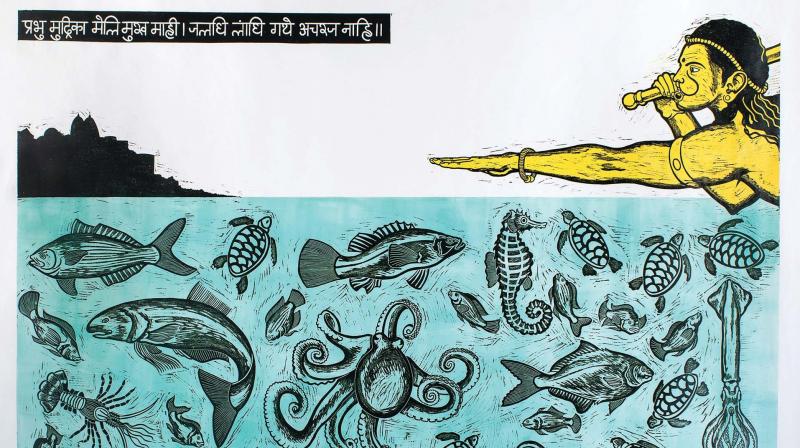When Chalisa inspired wood
The sacred hymn imbues its positive energy to this artist's showing in the city...

“The aim of art is to represent not the outward appearance of things, but their inward significance.
— Aristotle
Jai Hanuman Gyan Guna Sagar, Jai Kapish Timu Loka Ujagar For any Hindu, the Hanuman Chalisa is a sacred hymn where one seeks solace in times of distress and when in need of courage. The Chalisa comprises 40 verses or dohas extolling the mythological God’s heroism and goodness, and enumerating his important role in the Ramayana. Such is the power of Hanuman Chalisa, which has over 40 verses which are considered extremely powerful to drive out negative energies. Champa Sharath is that rare artist who has turned to the Hanuman Chalisa for inspiration. A set of 20 woodcuts by Champa Sharath inspired by the Hanuman Chalisa which was composed by the great poet and philosopher Tulsidas (1511-1623). Champa’s artistic engagement with the Hanuman Chalisa began more than a decade ago. The current series takes the artist’s exploration further, carrying nuances that touch upon both literal and symbolic representations. Often in Hindu mythology, Hanuman has always had a cult following. Also being considered by many as someone who had superhuman qualities, Hanuman is one of the rare Gods who has received Superhero status in India. These concise verses lend themselves meaningfully to visual interpretations.
 Champa Sharath
Champa Sharath
Champa has grasped an eclectic narrative in her acknowledgment of the lyrical writings. She questions the pertinence and relevance of faith in the contemporary setting, using artistic freedom to reclassify clichéd depictions and retelling folklore with a degree of playfulness and innocence. The realistic nature mirrors her strong repertoire of printmaking alongside a long haul and understanding of the woodcut medium. Champa depicts Hanuman through a multi-layered focal point by exploring him physically, figuratively, metaphorically and at times through partial abstraction. In most of the works, some important verses are inscribed in Sanskrit and show relevance of a particular context in a verse. She provokes her own discernments and establishes unique narratives that relate to her past, where she tuned in to the expressionof the Chalisa regularly, and her present, in which she is assessing and evaluating the profound subject as a creative artist. Hanuman and his mythical tales have been celebrated with elan, and the sheer elegance in which she has portrayed Hanuman as “One of our own” makes her work as interesting as it can get.
The exhibition is on at Gallery Sumukha till June 23.
— The writer is an art expert and curator.

